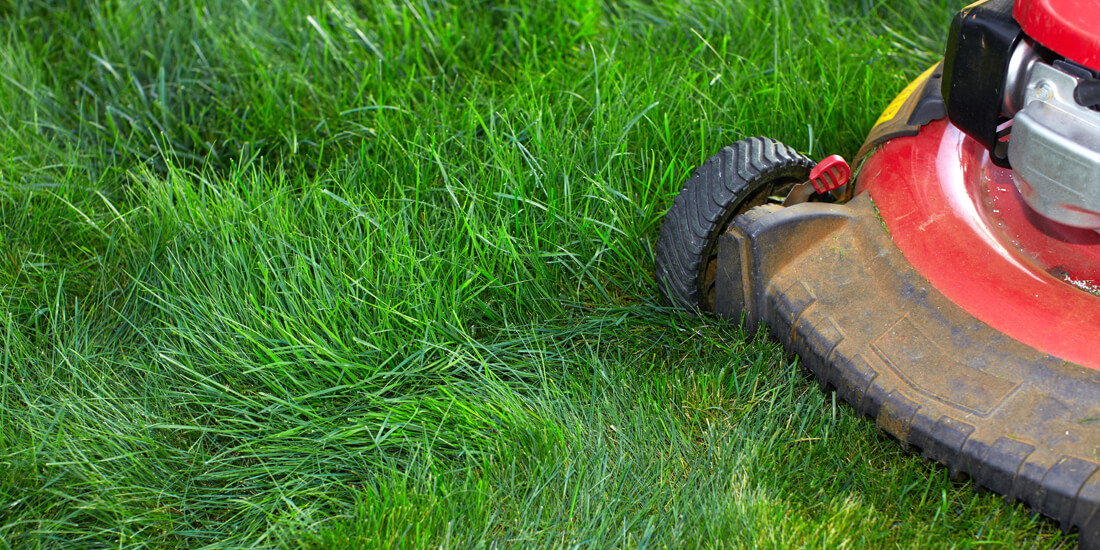When to mow and fertilise a new lawn

Knowing when to mow and fertilise your newly seeded lawn can become a bit of a conundrum, especially when summer growth can make new lawns appear established within just a few weeks. So join us as we delve into the best times to bring the mower, and lawn food to your new garden lawn.
However, whilst your lawn may appear flush with lush new grass that looks like it can withstand anything, it is important to remember that the grass seed is still establishing its root system beneath the soil. Above all else, it's important you know when to mow and fertilise a new lawn to make sure you get the timing right for the best growth!
When should I mow a new lawn?
Whether you’ve overseeded or sown a new lawn from scratch, we can understand the itch to get mowing, as once grass starts growing – it grows fast! This can make it appear that your lawn is ready to be mown. Yet, if you were to look at your lawn from a bird’s eye view – you may notice some spots you have missed or some patches that are taking a little longer to grow.
Wait 6-8 weeks before mowing a new lawn
This is normal, and we recommend waiting the full 6-8 weeks after sowing your new lawn to consider mowing it. After this amount of time, your lawn should be established. If you find that the lawn has good coverage throughout and the sward is reaching a uniform height of around 5-7cm, it is ready for its first mow.
Mow with your lawnmower on the highest setting for the first cut
When mowing your new lawn for the first time, make sure to mow first on the highest setting on your lawn mower, gradually dropping down to the recommended mowing height for your grass seed mixture/species. You can find the recommended mowing heights for all our grass seed mixtures in our guide on mowing your lawn.It is vital that you stick to the recommended mowing height for your mix. This is because species such as perennial ryegrass will not tolerate close mowing and can be hindered by cutting too low. It's also important you keep your lawn mower serviced, and it's blades sharp - because blunt mower blades can do your grass more harm than good!
Now we have addressed when and how to mow your new lawn; the next step is to consider when to fertilise.
When should I fertilise a new lawn?
When your new grass grows, it will be undeniably green and lush and most likely stay this way for the first few months post-sowing. However, a lawn is a living thing and requires nutrients to keep it looking its very best - and the best way to do this is to fertilise it!
Adopt a regular fertilising routine for the best lawn
A regular fertilising routine is a good habit to get into and can also keep your lawn protected against drought in summer and frost and winter-borne diseases in the colder months. Considering many lawns in the UK go without a feed for years, a regular fertilising routine can mean as little as two applications of seasonal slow-release fertiliser per year or four applications of a seasonal quick-release fertiliser per year.If you’re still pondering whether to add fertiliser to your lawn, read our blog on why using lawn feed is important. If you have applied any type of fertiliser to your lawn prior to sowing, make sure to wait the allotted time (the instructions will suggest a waiting period) before applying any more fertiliser.
- You can apply a Quick Release: Spring / Summer fertiliser when the lawn is 6 - 8 weeks old or our Slow Release: Spring / Summer fertiliser.
- For a fast-acting lawn feeding solution, our liquid fertilisers offer 6-8 weeks of feeding to give your grass nutrients quickly.
- Avoid applying a Feed, Weed and Moss Killer product until the lawn is at least six months old – you can find out more about weed control in a newly seeded lawn here.
- Mowing the lawn prior to applying fertiliser will help you see where you are spreading the product.
- Make sure to water any fertiliser in, as it will scorch the blades if not dissolved.
Remember, if you have any Before / After photos of your lawn from using our products, we offer a 20% discount code for this. So if you need some fertiliser, make sure to take some photos to get discount off a future purchase!
We have additional advice and guides for further reading on how and when to mow and fertilise your lawn: